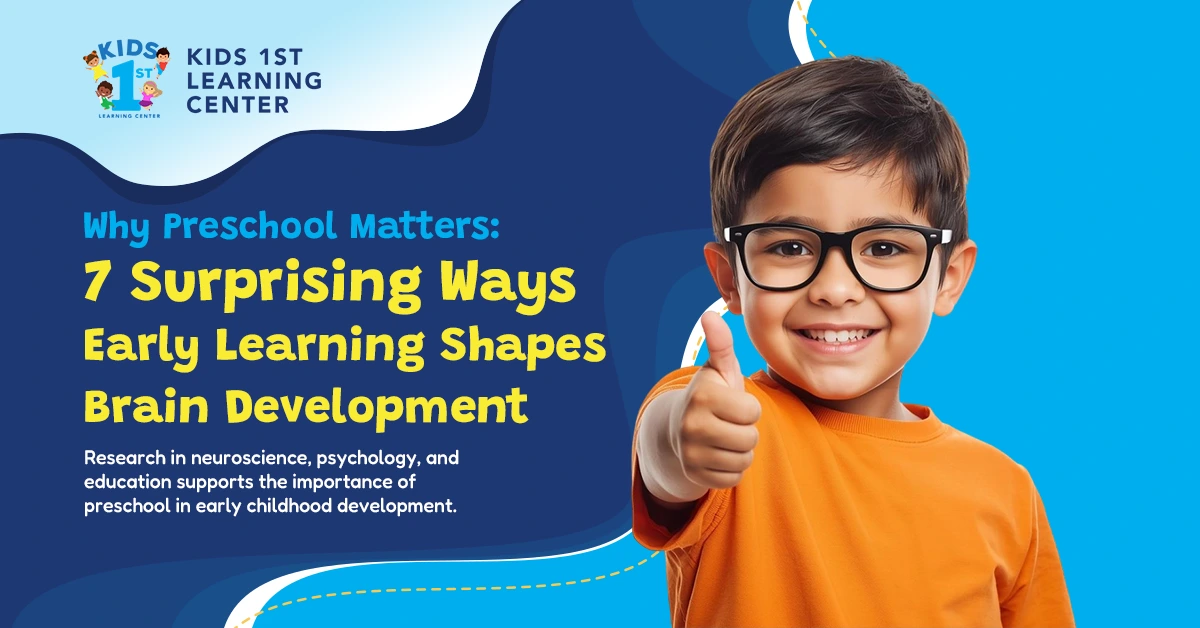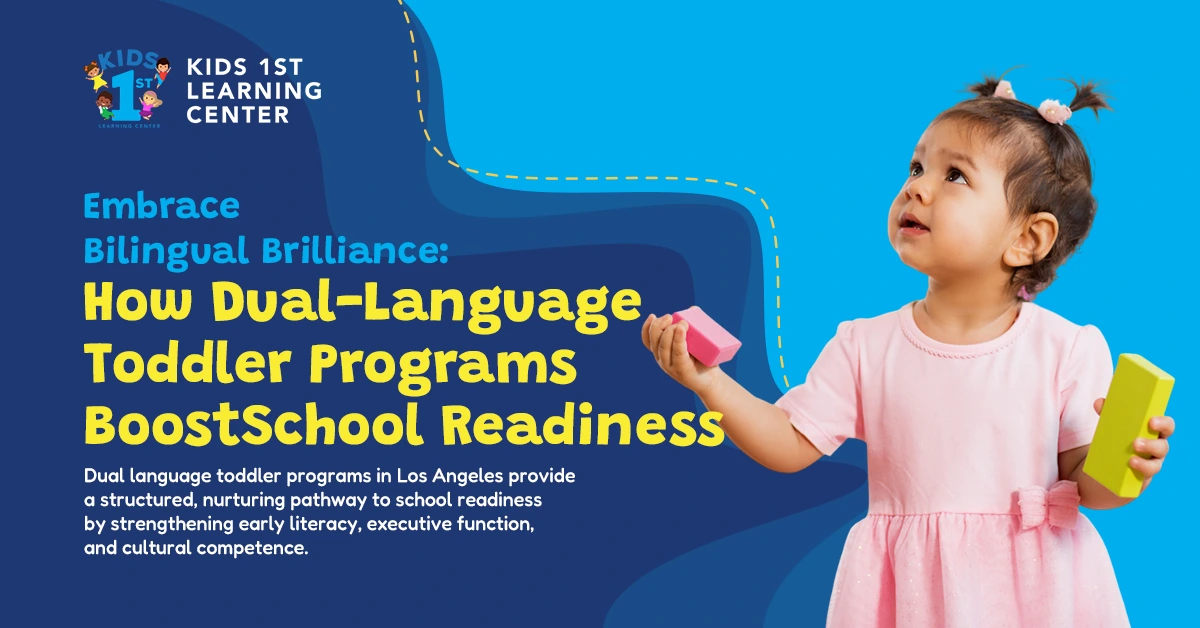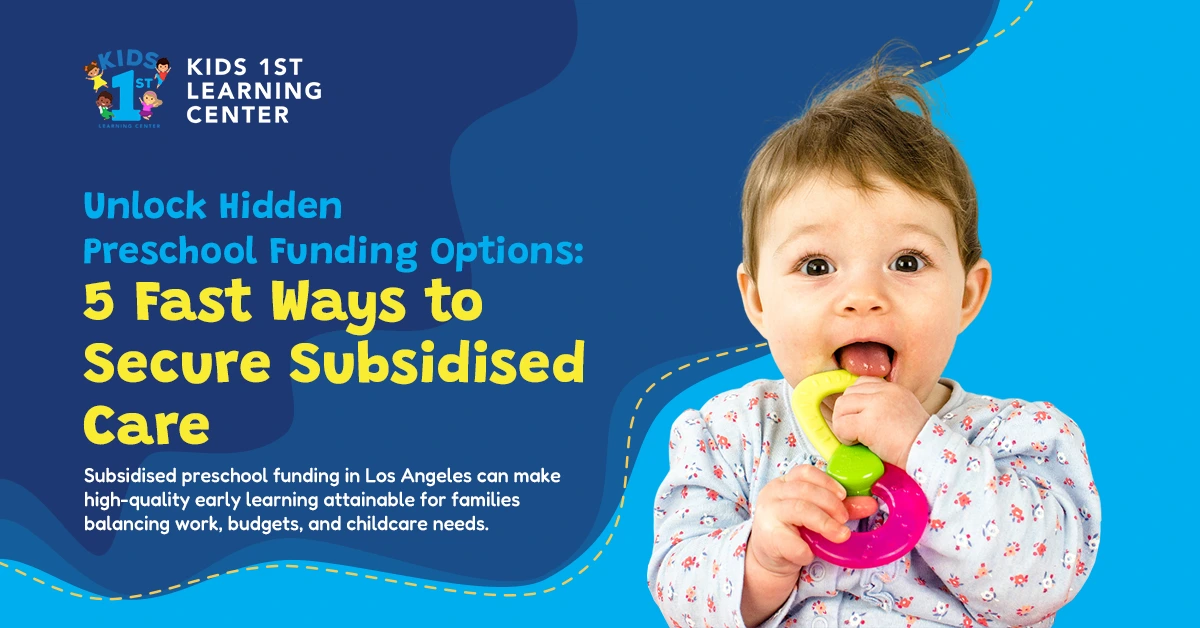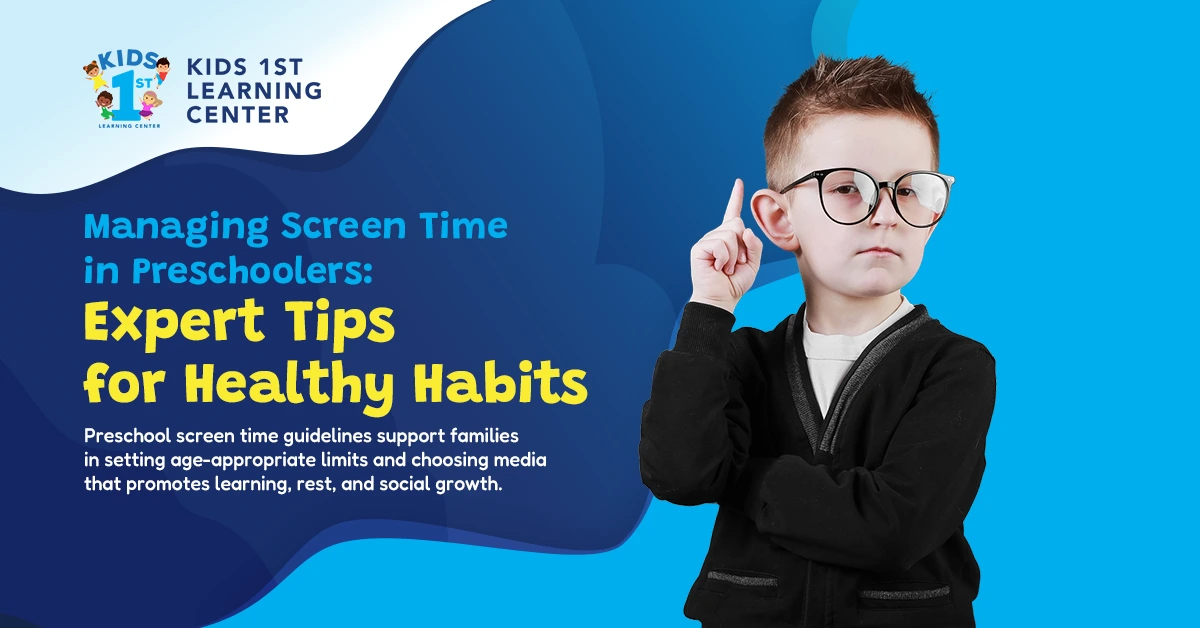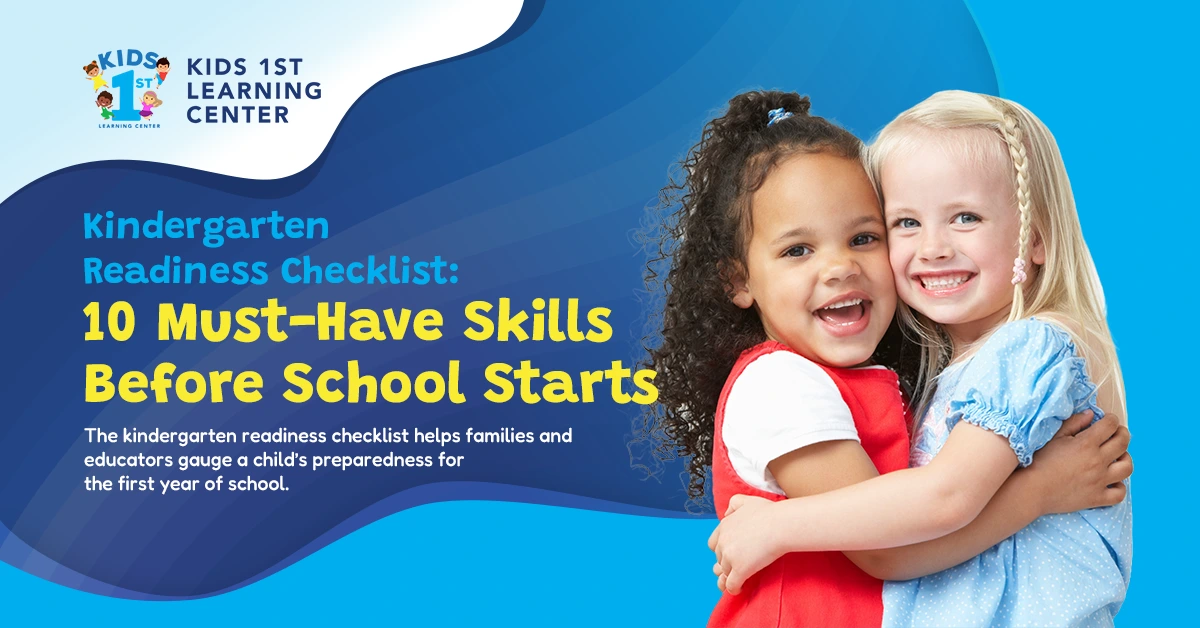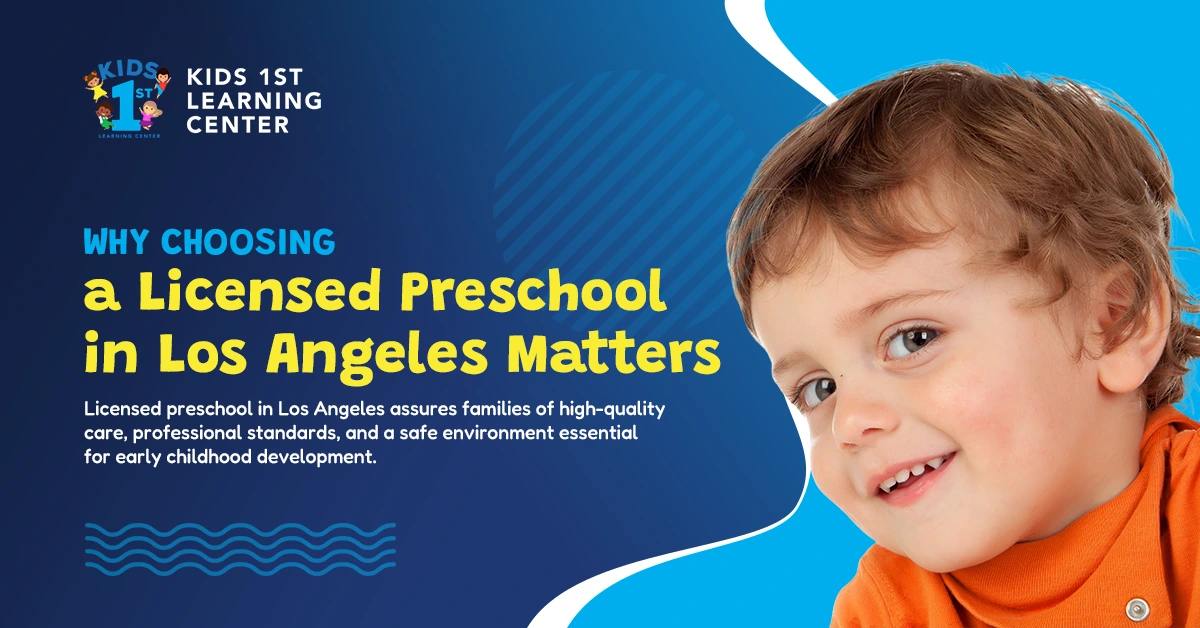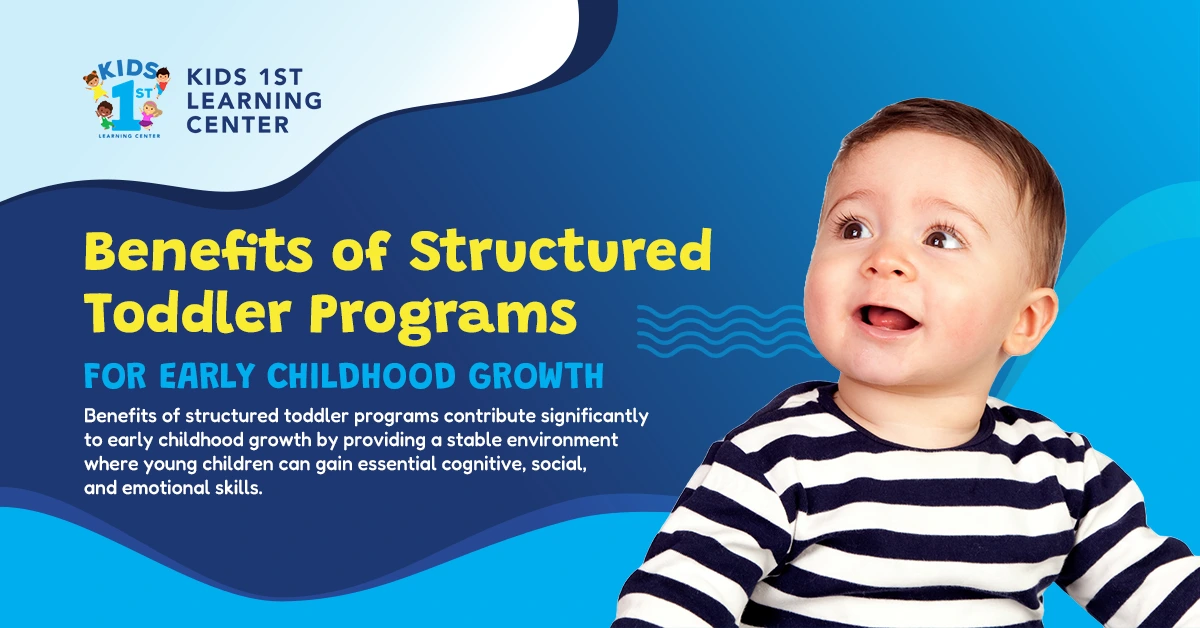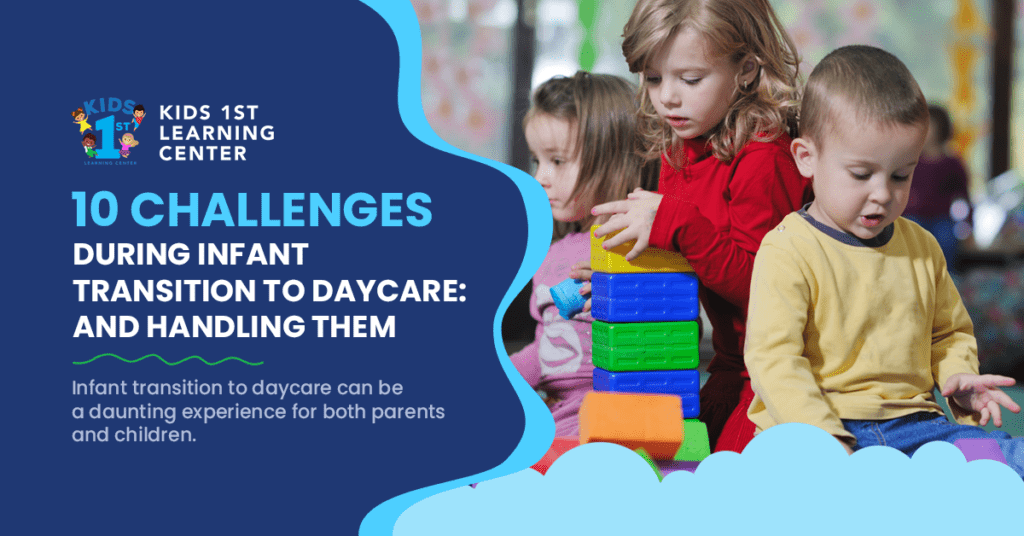
Infant transition to daycarecan be a daunting experience for both parents and children. Leaving your little one in the care of others might stir a mix of emotions, but understanding the everyday challenges can make the process smoother. This blog will explore the top 10 challenges during the infant transition to daycare and provide practical tips to handle them effectively.
At Kids 1st, we believe in creating a nurturing environmentwhere your child feels safe, loved, and ready to thrive. Let’s delve into these challenges and discover how to turn this significant milestone into a positive experience for you and your infant.
1. Separation Anxiety
Separation anxietyis common when transitioning infants to daycare. It can be heart-wrenching to see your little one distressed as you leave, but understanding this anxiety is the first step towards easing it.
Understanding Separation Anxiety
Separation anxiety typically begins around six months and can peak around 18 months. It’sa normal part of development, reflecting a strong bond between you and your child. Your infant’s tears and clinginess are their way of expressing discomfort with the new routine.
Tips for Easing the Anxiety
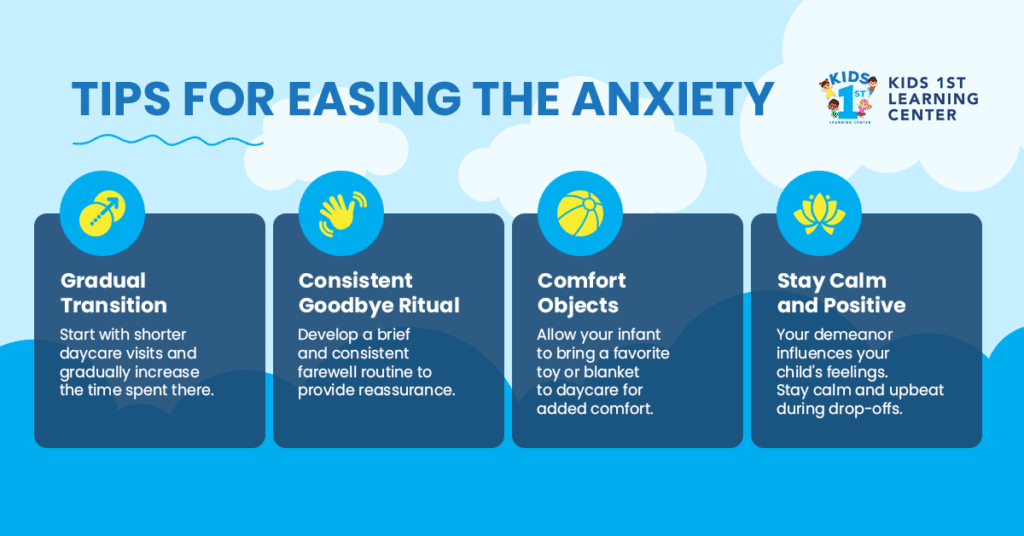
- Gradual Transition:Start with shorter daycare visits and gradually increase the time spent there.
- Consistent Goodbye Ritual:Develop a brief and consistent farewell routine to provide reassurance.
- Comfort Objects:Allow your infant to bring a favorite toy or blanket to daycare for added comfort.
- Stay Calm and Positive:Your demeanor influences your child’s feelings. Stay calm and upbeat during drop-offs.
Role of Parents and Caregivers
Parents and caregivers are vital in easing separation anxiety. Caregivers should provide a warm, welcoming environment and be patient and understanding. They can engage infants in fun activities to distract them from their parents’ absence. Parents should communicate openly with caregivers about their child’s needs and progress. By working together, they can form a supportive atmosphere that helps infants adjust more smoothly to daycare.
2. Adjusting to New Environments
Adjusting to new environmentscan be challenging for infants, especially during that period. Familiarization makes this process smoother in helping infant transition to daycare.
Importance of Familiarization
Familiarizing your infant with the daycare setting helps reduce anxiety and fear of the unknown. Visiting the daycare before the start date can help your child get used to the new surroundings, sounds, and faces. This gradual exposure can make the transition less overwhelming.
Strategies for Helping Infants Transition to Daycare Smoothly
- Short Visits:Begin with short visits to the daycare, gradually extending the time as your infant becomes more comfortable.
- Meet the Caregivers:Introduce your child to the caregivers beforehand, allowing them to build trust and familiarity.
- Talk About Daycare:Discuss daycare positively at home, using simple words and an enthusiastic tone to create excitement.
- Consistent Routine:Establisha consistent drop-off and pick-up routine to provide security and predictability.
Creating a Home-Like Atmosphere
Daycare centers can create a home-like atmosphere by incorporating familiar elements from home. Caregivers can set up cozy areas with soft lighting and comfortable seating, use familiar scents, and play soothing music. Displaying photos of family members can also provide comfort. Personalizing your child’s space with their belongings can make the daycare environment feel more like home, easing the transition and helping your infant feel safe and secure.
3. Sleep Routine Disruptions
Sleep routine disruptions are a common concern when transitioning infants to daycare. Ensuring your child gets appropriate restis crucial for their development and well-being. It is one of the most important infant transition activities.
Common Sleep Challenges in Daycare
Daycare environments can present various sleep challenges for infants. The new surroundings, noise levels, and different sleep schedules can make it difficult for your little one to settle down and nap. Infants may also experience shorter naps or have trouble adjusting to the communal sleep areas.
Establishing a Consistent Sleep Schedule
- Consistent Bedtime Routine:Maintaina consistent bedtime routine at home to reinforce sleep patterns. A warm bath, storytime, or gentle rocking can signal your infant that it’stime to sleep.
- Align with Daycare Schedule:If possible, align your child’s nap schedule at home with the daycare’s nap times. This consistency can help your infant adjust more smoothly.
- Communicate with Caregivers:Share your child’s sleep patterns and preferences with the daycare staff. Open communication ensures that caregivers can best support your child’s sleep needs.
Transitioning Infants to Daycare with Minimal Sleep Disruption
To minimize sleep disruptions, introduce elements of the daycare sleep environment at home before the transition. If the daycare uses cotsor specific bedding, incorporate similar itemsinto your child’s sleep routine. Bringing a familiar blanket or sleep toy from home to daycare can provide comfort and promote better sleep. Additionally, caregivers can help soothe infants by creating a calming atmosphere with dim lighting and soft music during nap times.
Addressing Feeding Issues During Your Infant's Transition to Daycare

Feeding issues can be a significant challenge when transitioning infants to daycare. Adapting to new feeding schedules and methods, ensuring clear communication between parents and caregivers, and meeting nutritional needsis crucial for a smooth transition.
Adapting to New Feeding Schedules and Methods
Transitioning to daycare often means adjusting to a new feeding schedule. Daycare centers typically follow a set routine, which might differ from your infant’s feeding times. To ease this transition, gradually shift your child’s feeding schedule at home to match the daycare’s routine. Additionally, if the daycare uses different feeding methods, such as bottle-feeding instead of breastfeeding, introduce these methods at home beforehand to help your infant adapt.
Communication Between Parents and Caregivers
Effective communication between parents and caregivers is essential for addressing feeding issues. Share detailed information about your infant’s feeding preferences, allergies, and special instructions with the daycare staff. Regular updates on your child’s feeding patterns and any changes in their diet can help caregivers provide consistent care. A communication notebook or a daycare app can ensure that both parties stay informed and promptly address any concerns.
Ensuring Nutritional Needs Are Met
Meeting your infant’s nutritional needs is paramount during the transition. Ensure the daycare provides a balanced, age-appropriate diet that meets your child’s nutritional requirements. Discuss these with the daycare staff and providesuitable alternatives if your infant has specific dietary needs, such as allergies or intolerances. Pack nutritious snacks or meals if necessary, and regularly check in with caregivers to monitoryour child’s eating habits and overall well-being.
5. Bonding with Caregivers
Bonding with caregivers is crucial for a smooth transition to daycare. Building trust and relationships with daycare staff, engaging in activities that strengthen these bonds, and encouraging positive interactions can significantly impactyour infant’s experience.
Building Trust and Relationships with Daycare Staff
Trust is the foundation of any relationship and is essential between your infant and their caregivers. Start by gradually introducing your child to the caregivers, allowing time for them to become familiar with each other.
Share important details about your child’s routines, preferences, and special needs. This transparency helps caregivers provide personalized care and builds trust. Regular communication through updates and check-ins fosters a strong connection and reassures parents and infants.
Activities to Strengthen Caregiver-Infant Bonds
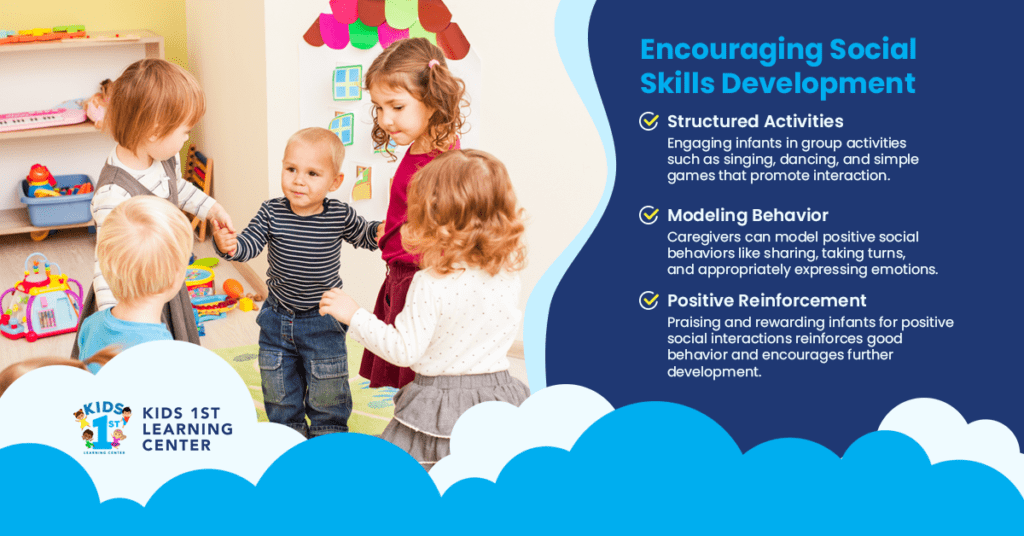
Engaging in activities promoting bonding can help caregivers and infants develop a close relationship. Here are some suggestions:
- Routine Activities:Caregivers can incorporate daily routines such as feeding, diaper changes, and nap times to create a sense of security and familiarity.
- Playtime:Interactive play, including singing, reading, and gentle games, can help build a positive and nurturing relationship.
- Comfort Objects:Allowing infants to bring a favorite blanket can provide comfort and help them feel more at ease with caregivers.
Encouraging Positive Interactions
Positive interactions between infants and caregivers are essential for building a strong bond. Caregivers should use a warm, gentle approach, offering plenty of eye contact, smiles, and comforting touch. Encouraging infants to express themselves and respond to their needs promptly fosters a sense of security. Parents can support this by expressing confidence in the caregivers and reinforcing positive experiences at home.
6. Socialization with Other Children
Socialization with other children is a vital aspect of transitioning infants to daycare. Introducing infants to group settings, encouraging social skills development, and managing conflicts while fostering friendships can significantly enhance their daycare experience.
Introducing Infants to Group Settings
Introducing infants to group settings can be challenging but rewarding. Start with brief playdates or visits to the daycare to help your child become accustomed to being around other children. Gradually increase the duration of these interactions to build comfort and familiarity. Observing other children at play and participatingin group activities can help infants feel more at ease and adapt to the social environment.
Encouraging Social Skills Development
Daycare provides an excellent opportunity for infantsto develop essential social skills. Caregivers can encourage this development through:
- Structured Activities:Engaging infants in group activities such as singing, dancing, and simple games that promote interaction.
- Modeling Behavior:Caregivers can model positive social behaviors like sharing, taking turns, and appropriately expressing emotions.
- Positive Reinforcement:Praising and rewarding infants for positive social interactions reinforces good behavior and encourages further development.
Managing Conflicts and Fostering Friendships
Conflicts are a natural part of socialization, even for infants. Caregivers play a crucial role in managing these situations by:
- Observingand Intervening:Monitoring interactions to prevent conflicts and stepping in when necessary to guide infants toward peaceful resolutions.
- Teaching Conflict Resolution:Helping infants understand and manage their emotions, encouraging them to use words or gestures to express their feelings.
- Fostering Friendships:Creating opportunities for infants to bond with peers through cooperative play and shared activities. Encouraging friendships helps infants build trust and feel more secure in the daycare environment.
7. Health and Hygiene Concerns
Health and hygiene are top priorities when transitioning infants to daycare. Maintaining a clean and safe environment, implementing policies for illness prevention, and educating parents about daycare hygiene practices are crucial for ensuring the well-being of all children.
Maintaining a Clean and Safe Environment
A cleanand safe surrounding minimizes health risks. Daycare centers should adhere to strict cleaning protocols, including:
- Daily Cleaning:Regularly disinfecting toys, play areas, and common surfaces to reduce the spread of germs.
- Proper Hand Hygiene:Ensuring caregivers and infants wash their hands frequently, especially before meals and after diaper changes.
- Safe Facilities:Keeping the daycare facility safe by childproofing areas, securing furniture, and regularly inspecting equipment for safety.
Policies for Illness Prevention
Daycare centers must have clear policies to prevent the spread of illnesses. These policies may include:
- Sick Child Policy:Requiring children with contagious illnesses to stay home until they are no longer infectious.
- Vaccination Requirements:Ensuring that all children are up-to-datewith their vaccinations to protect against common diseases.
- Health Screenings:Conducting daily health checks to monitorfor signs of illness and prevent infections within the daycare.
Educating Parents About Daycare Hygiene Practices
Educating parents about daycare hygiene practices fosters a collaborative approach to health and safety. Daycare centers can:
- Provide Information:Share guidelines and tips on maintaininggoodhygiene at home and in the daycare setting.
- Communicate Regularly:Keep parents informed about any illness outbreaks and the measures being taken to address them.
- Encourage Good Habits:Encourage parents to reinforce handwashing and other hygiene practices at home to support the daycare’s efforts.
8. Separation from Familiar Objects
Separation from familiar objects can be challenging for infants as they transition to daycare. Coping with the absence of favorite toys and items, using transitional objects, and incorporating infant transition activities can help ease this process.
Coping with the Absence of Favorite Toys and Items
Infants often find comfort in their favorite toys and items, providing security and familiarity. The absence of these objects in a new environmentcan cause distress. To help your child cope, gradually reduce their time with these items at home before transitioning to daycare. Encourage them to explore other toys and activities to build their adaptability.
Using Transitional Objects
Transitional objects, such as a beloved blanket or a favorite stuffed animal, can offer comfort and reassurance to infants in a new setting. Allow your child to bring one or two transitional objects to daycare. These items can bridge the gap between home and daycare, providing a sense of continuity and security. Communicate with caregivers about the importance of these objects so they can ensure your child can access them during times of need.
Incorporating Infant Transition Activities
Incorporating specific activities can help infants feel more at ease without their familiar objects. Caregivers can:
- Create Familiar Routines:Establishroutines similar tothose at home, such as nap time or a favorite song during playtime.
- Engage in Comforting Activities:Activities like reading a familiar book, gentle rocking, or quiet time can help soothe infants and make them feel secure.
- Gradual Exposure:Gradually increaseinfants’ time without familiar objects, allowing them to build confidence and independence.
9. Parental Guilt and Anxiety
Parental guilt and anxiety are common feelings when transitioning infants to daycare. Addressing parents’ emotional challenges, seeking support and reassurance, and balancing work and childcare responsibilitiescan help ease these feelings and make the transition smoother for both parents and infants.
Addressing Parents' Emotional Challenges
Feeling guilty or anxious about leaving your infant at daycare is natural. Acknowledge these emotions and understand that it’sokay to feel this way. Remember that choosing a quality daycare provides your child with opportunities for growth and development. Talking to other parents with similar feelings can also be comforting and providevaluable insights.
Seeking Support and Reassurance
Seeking support from friends, family, and daycare staff can help alleviate parental guilt and anxiety. Share your concerns with the daycare caregivers and request updates on your child’s progress. Knowing that your infant is incapable and caring hands can provide reassurance. Joining parent groups or forums where you can discuss your feelings and receive encouragement from others in similar situations can also be beneficial.
Balancing Work and Childcare Responsibilities
Balancing work and childcare responsibilities isa common challenge for many parents. To manage this balance:
- Create a Schedule:Develop a consistent schedule that includes dedicated time for work and quality time with your child.
- Set Boundaries:Establishprecise boundaries between work and family time to ensure you can focus fully on your child when you’retogether.
- Flexible Work Arrangements:If possible, explore flexible work arrangements with your employer, such as remote work or adjusted hours, to accommodate your childcare needs.
10. Communication Gaps
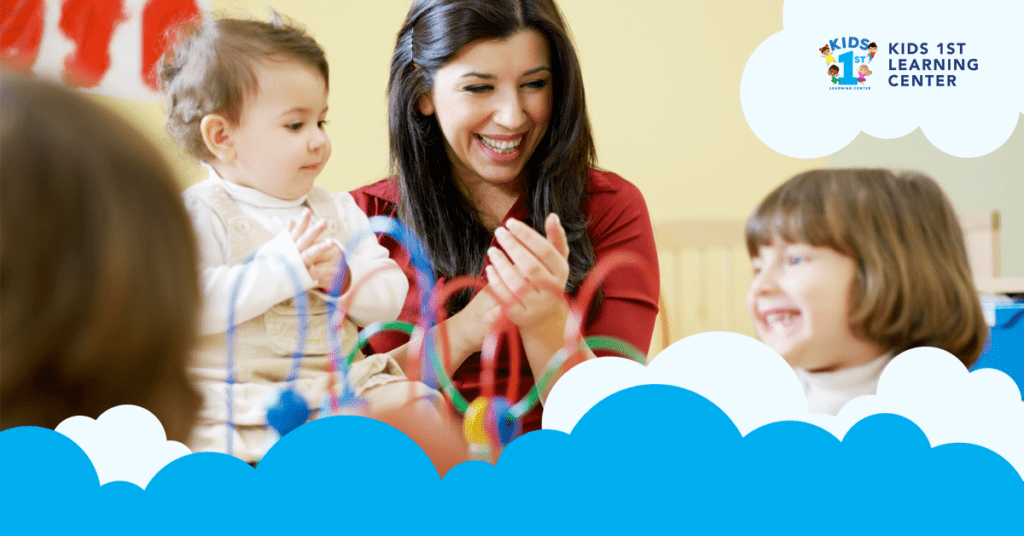
Effective communication is crucial when transitioning infants to daycare. Ensuring effective communication, sharing daily reports and updates, and using technology for seamless interaction can bridge communication gaps and create a supportive environment for your child.
Ensuring Effective Communication Between Parents and Caregivers
Open and transparent communication is critical to understanding and meeting your infant’s needs. Establish a routine for regular check-ins with caregivers to discuss your child’s progress, preferences, and concerns. Provide detailed information about your child’s routine, habits, and special needs to help caregivers provide consistent care. Encouraging a two-way dialogue ensures that parents and caregivers are informed and aligned.
Sharing Daily Reports and Updates
Daily reports and caregiver updates providevaluable insights into your child’s day at daycare. These reports can include information about your infant’s feeding, nap times, activities, and overall mood. Regular updates help parents feel connected and reassured about their child’s well-being. Caregivers can share this information using written reports, verbal updates during pick-up and drop-off, or dedicated communication apps.
Using Technology for Seamless Interaction
Technology can facilitateseamless communication between parents and caregivers. Utilizing daycare management apps or communication platforms allows for real-time updates, photos, and messages. These tools inform parents about their child’s activities and milestones throughout the day. Video calls or virtual meetings can be scheduled for more detailed discussions, ensuring that both parties are on the same page.
Conclusion
Transitioning infants to daycare is a significant milestone filled with challenges and rewards. By understanding and addressing common issues like separation anxiety, adjusting to new environments, sleep routine disruptions, feeding issues, bonding with caregivers, socialization with other children, health and hygiene concerns, separation from familiar objects, parental guilt and anxiety, and communication gaps, parents can ensure a smoother, more positive experience for their little ones.
Ready to take the next step in your child’s daycare journey? Contact us today to learn more about our programs and how we can support your family. Visit our contact pageor call us at (818) 873-0133. We look forward to welcoming you to the Kids 1st family!

